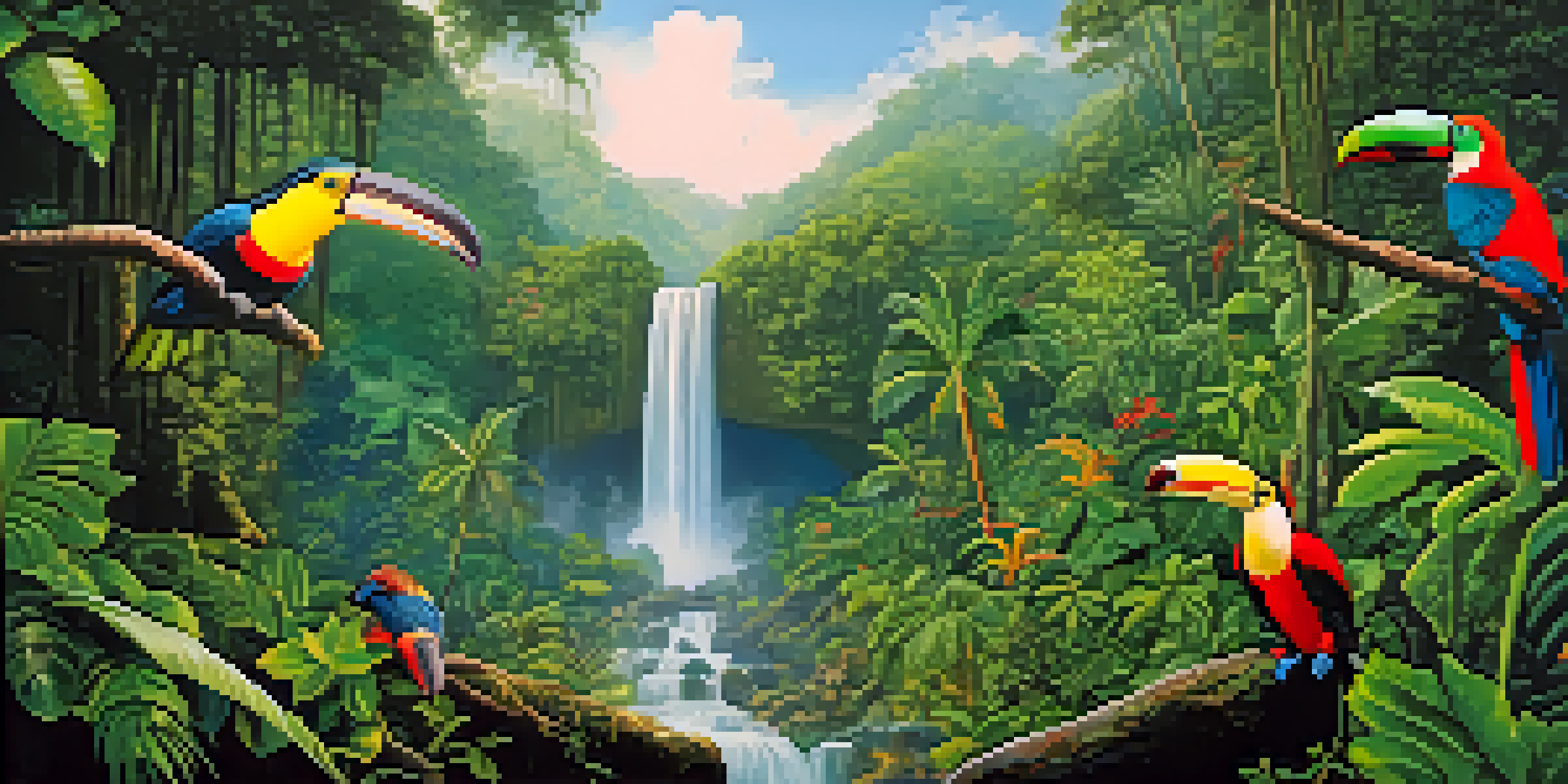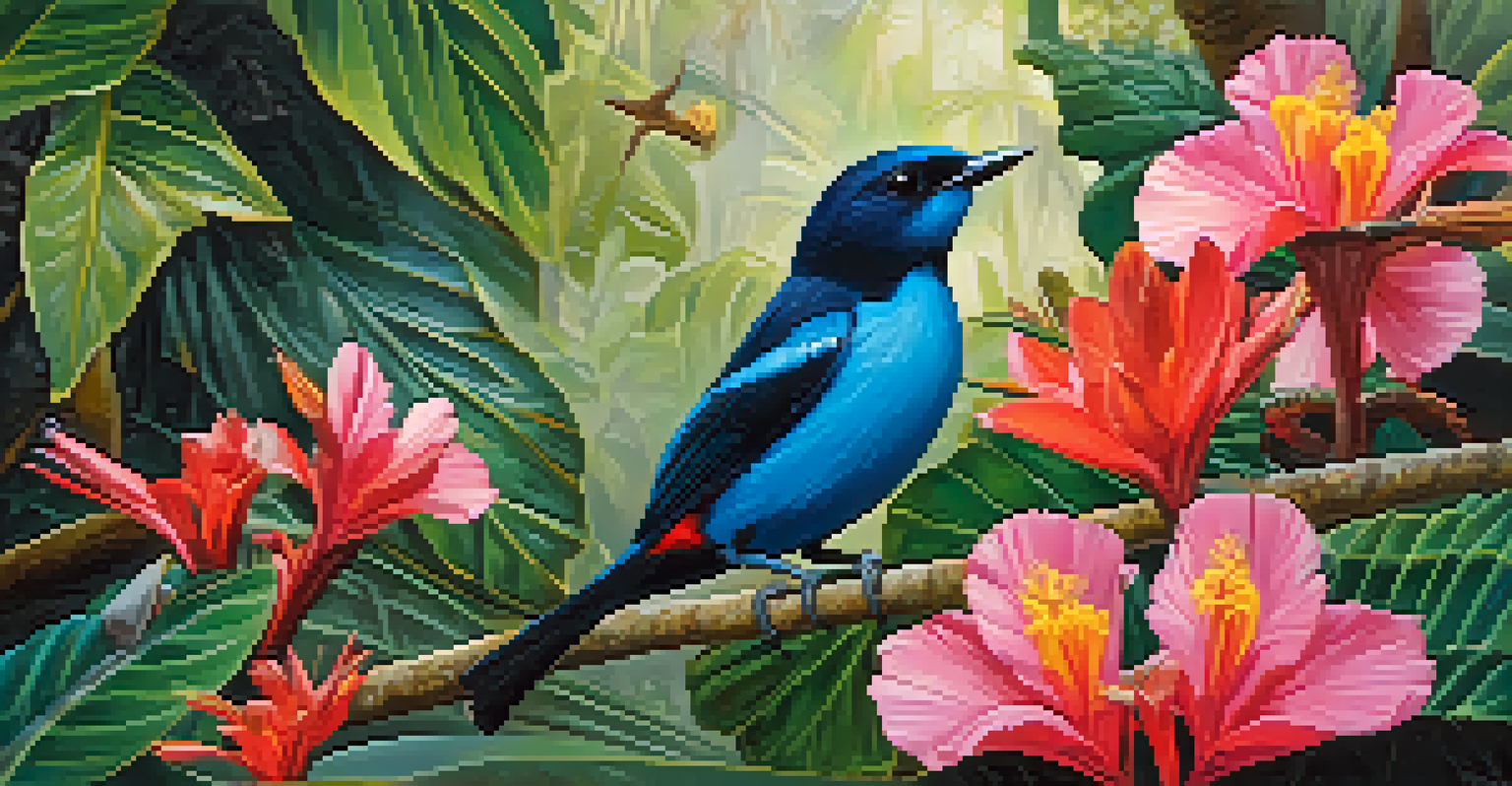Birdwatching in Brazil's National Parks: Best Spots

The Magic of Brazil's Biodiversity for Birdwatchers
Brazil boasts an incredible array of ecosystems, from the Amazon rainforest to the Pantanal wetlands. This diversity makes it a paradise for birdwatchers, offering a chance to see thousands of species in their natural habitats. The country's unique geographical features and climate contribute to its rich avian population, which includes everything from the iconic toucan to the elusive harpy eagle. For bird enthusiasts, Brazil is not just a destination; it's a bucket-list experience.
In every walk with nature one receives far more than he seeks.
As you explore these national parks, you'll find that each region presents its own unique birding opportunities. Whether it's the vibrant colors of the Amazon or the stark beauty of the cerrado, the variety of environments creates a feast for the eyes. This variety is what keeps birdwatchers coming back, as there's always something new to discover. Moreover, the thrill of spotting a rare bird is like finding a hidden treasure.
Birdwatching in Brazil is not just about the birds; it's also about the experience of being immersed in nature. The sounds of chirping, rustling leaves, and distant calls create an atmosphere that is both calming and exhilarating. As you stand quietly in the midst of these diverse ecosystems, you become part of something larger, connecting with nature in a profound way.
Top National Parks for Birdwatching in Brazil
Brazil is home to several national parks that stand out as premier birdwatching destinations. Among them, Chapada dos Guimarães National Park in Mato Grosso is famous for its stunning landscapes and abundant birdlife. Here, you can spot species like the red-and-green macaw and the yellow-billed cardinals, all while enjoying breathtaking views of cliffs and waterfalls. Each visit promises new discoveries and unforgettable moments.

Another must-visit location is the Pantanal, the world's largest tropical wetland, which teems with life. The Pantanal is particularly famous for its aquatic birds, such as the jabiru stork and the kingfishers. Guided tours often provide the best opportunities to see these magnificent creatures up close, allowing you to capture that perfect photograph. The sheer scale of the Pantanal means that each outing can yield surprising encounters.
Brazil: A Birdwatcher's Paradise
With its diverse ecosystems, Brazil offers birdwatchers the chance to see thousands of species in their natural habitats.
For a unique experience, the Atlantic Forest region, particularly in Tijuca National Park, is a hidden gem. This area is known for its rich biodiversity and is home to several endemic species. Birdwatchers can expect to see the colorful plumage of the Brazilian tanager and the striking black-capped screech owl. The combination of urban accessibility and vibrant wildlife makes Tijuca a fantastic stop for both novice and experienced birders.
Planning Your Birdwatching Adventure
When planning your birdwatching trip to Brazil, timing can greatly influence your experience. The best time to visit is typically during the dry season, from May to September, when birds are more active and visible. Early mornings are particularly rewarding, as many species are more easily spotted while they are feeding. Don't forget to check local birding calendars for special events or migratory patterns that could enhance your adventure.
The clearest way into the Universe is through a forest wilderness.
Packing the right gear is essential for a successful birdwatching trip. A good pair of binoculars, a field guide specific to Brazilian birds, and a notebook to jot down your sightings are must-haves. Additionally, comfortable clothing, sturdy shoes, and insect repellent will ensure you are well-prepared for long hours in the field. Being comfortable allows you to focus on the beauty around you rather than the discomfort of your gear.
Lastly, consider hiring a local guide who knows the best spots and can help you identify various species. These guides can provide invaluable insights into bird behavior and habitat, enhancing your overall experience. Their expertise can make the difference between a good trip and an unforgettable one. Plus, supporting local guides contributes to the conservation of these precious ecosystems.
Essential Birdwatching Etiquette
As you embark on your birdwatching journey, it's important to adhere to certain etiquette to protect both the birds and their habitats. Always maintain a respectful distance from the birds to avoid causing them stress or disturbance. This is especially crucial during nesting seasons when birds are particularly vulnerable. Remember, our goal is to observe and appreciate, not to intrude.
Keeping noise levels down is another key aspect of birdwatching etiquette. Birds rely heavily on sound for communication and awareness of their surroundings. By being quiet, you improve your chances of spotting more species while also being considerate to other birdwatchers around you. It’s all about creating a peaceful environment that allows everyone to enjoy the beauty of nature.
Top Parks for Birdwatching
National parks like Chapada dos Guimarães and the Pantanal are premier destinations for observing a wide variety of bird species.
Lastly, consider the impact of your presence on the environment. Stick to marked trails to minimize your ecological footprint and avoid trampling on sensitive vegetation. Leaving no trace, such as disposing of trash properly and not feeding wildlife, ensures that these beautiful parks remain pristine for future generations of birdwatchers. Practicing good etiquette is a small effort that makes a big difference.
Unique Bird Species to Look Out For
Brazil is home to over 1,800 bird species, making it a veritable paradise for birdwatchers. One of the standout species is the toucan, easily recognizable by its large, colorful bill and vibrant plumage. These birds are not just beautiful; they play a crucial role in their ecosystems by helping to disperse seeds. Spotting a toucan in the wild is often a highlight of any birdwatching adventure.
Another remarkable species to keep an eye out for is the hyacinth macaw, the largest flying parrot in the world. With its stunning blue feathers and playful nature, this bird is a favorite among birdwatchers. While they are often found in pairs, they can be seen soaring majestically over the Pantanal in search of palm nuts. Witnessing their beauty in flight is an experience that stays with you long after your trip.
Lastly, don’t miss the chance to see the Brazilian blue manakin, a small bird known for its striking coloration and unique courtship displays. The males perform an elaborate dance to attract females, making it a delightful spectacle to observe. This species is just one example of the many unique birds you can encounter, reminding you of the endless wonders that await in Brazil's national parks.
Conservation Efforts and Their Importance
As birdwatchers, we hold a unique responsibility in supporting conservation efforts in Brazil. Many of the national parks are home to endangered species whose habitats are threatened by deforestation and urban expansion. By visiting these parks and engaging with local conservation initiatives, we can contribute to the preservation of these vital ecosystems. Each ticket purchased or donation made helps fund protection efforts.
Participating in birdwatching tours that prioritize sustainable practices is another way to make a positive impact. Many operators are committed to eco-friendly practices, ensuring that their activities do not harm the environment. By choosing these responsible options, you help promote a model of tourism that benefits both the local communities and the wildlife they cherish. It's a win-win situation for everyone involved.
Conservation Through Birdwatching
Engaging in birdwatching supports conservation efforts, helping to preserve Brazil's endangered species and their habitats.
Additionally, sharing your birdwatching experiences can raise awareness about the importance of conservation. Whether through social media, blogs, or community events, spreading the word about the beauty and fragility of Brazil's avian diversity can inspire others to take action. Together, we can create a community of passionate birdwatchers dedicated to protecting the natural world for generations to come.
Final Thoughts on Birdwatching in Brazil
Birdwatching in Brazil's national parks offers a unique blend of adventure, relaxation, and connection with nature. From the vibrant birds to the stunning landscapes, every moment spent in these parks is an opportunity to appreciate the beauty of the natural world. The thrill of spotting a rare species or simply enjoying the serene environment is what makes birdwatching such a rewarding experience.
As you plan your adventures, remember that each park has its own charm and unique birding opportunities. Whether you choose to explore the depths of the Amazon or the vastness of the Pantanal, you're sure to create lasting memories. Each trip deepens your appreciation for the intricate web of life that exists in these ecosystems.

Ultimately, birdwatching is about more than just the birds; it's about fostering a love for nature and understanding our role in protecting it. With every sighting and every shared experience, you become part of a larger movement dedicated to conservation and appreciation of our planet's incredible biodiversity. So grab your binoculars and get ready to embark on a journey through Brazil's breathtaking national parks!